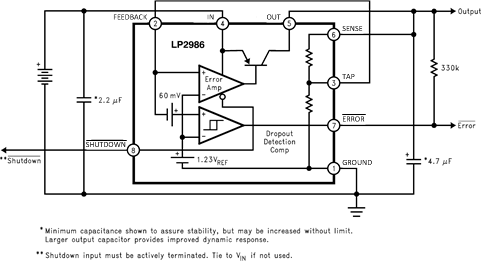SNVS137I March 1999 – September 2015 LP2986
PRODUCTION DATA.
- 1 Features
- 2 Applications
- 3 Description
- 4 Revision History
- 5 Pin Configuration and Function
- 6 Specifications
- 7 Detailed Description
- 8 Application and Implementation
- 9 Power Supply Recommendations
- 10Layout
- 11Device and Documentation Support
- 12Mechanical, Packaging, and Orderable Information
封装选项
机械数据 (封装 | 引脚)
散热焊盘机械数据 (封装 | 引脚)
订购信息
7 Detailed Description
7.1 Overview
The LP2986 is a bipolar, low-dropout (LDO) voltage regulator that can accommodate a wide input supply-voltage range of up to 16 V. The LP2986 LDO is able to output either a fixed or adjustable output from the same device. By tying the OUT and SENSE pins together, and the FEEDBACK and TAP pins together, the LP2986 device outputs a fixed 5 V, 3.3 V, or 3 V (depending on the version). Alternatively, by leaving the SENSE and TAP pins open and connecting FEEDBACK to an external resistor divider, the output can be set to any value between 2.1 V to 16 V. The LP2986 device also offers additional functionality that makes it particularly suitable for battery-powered applications. For example, a logic-compatible shutdown feature allows the regulator to be put in standby mode for power savings. In addition, there is a built-in supervisor reset function in which the ERROR output goes low when VOUT drops by 5% of its nominal value for whatever reasons – due to a drop in VIN, current limiting, or thermal shutdown.
The LP2986 devices are designed to minimize all error contributions to the output voltage. With a tight output tolerance (0.5% at 25°C), a very low output voltage temperature coefficient (20 ppm typical), extremely good line and load regulation and remote sensing capability, the part can be used as either low-power voltage reference or 200-mA regulator.
Multiple features of the device include:
- Very high-accuracy 1.23-V reference
- Sleep mode
- Error flag output
- Internal protection circuitry, such as overcurrent limit, and thermal shutdown.
7.2 Functional Block Diagram

7.3 Feature Description
7.3.1 High-Accuracy Output Voltage
With special careful design to minimize all contributions to the output voltage error, the LP2989 distinguishes itself as a very high output-voltage-accuracy micro-power LDO. This includes a tight initial tolerance (0.5% typical, A grade), extremely good line regulation (0.007%/V typical).
7.3.2 Error Detection Comparator Output
The LP2989 will generate a logic low output whenever its output falls out of regulation by more than approximately 5% below nominal. Because the ERROR comparator has an open-collector output, an external pull-up resistor is required to pull the output up to VOUT or another supply voltage (up to 16 V). The output of the comparator is rated to sink up to 300 µA. If ERROR pin is not used, it can be left open.
Because the ERROR comparator has an open-collector output, an external pull-up resistor is required to pull the output up to VOUT or another supply voltage (up to 16 V). The output of the comparator is rated to sink up to 300 µA. If ERROR pin is not used, it can be left open.
7.3.3 Thermal Protection
The device contains a thermal shutdown protection circuit to turn off the output current when excessive heat is dissipated in the LDO. The circuitry is not intended to replace proper heat sinking. Continuously running the device into thermal shutdown degrades its reliability.
7.3.4 Short-Circuit Protection (Current Limit)
The internal current limit circuit is used to protect the LDO against high-load current faults or shorting events. The LDO is not designed to operate in a steady-state current limit. During a current-limit event, the LDO sources constant current. Therefore, the output voltage falls when load impedance decreases. Note also that if a current limit occurs and the resulting output voltage is low, excessive power may be dissipated across the LDO, resulting in a thermal shutdown of the output.
7.4 Device Functional Modes
7.4.1 Shutdown Mode
The LP2986 is shut off by driving the shutdown input low, and turned on by pulling it high. If this feature is not to be used, the SHUTDOWN input should be tied to VIN to keep the regulator output on at all times.
To assure proper operation, the signal source used to drive the SHUTDOWN input must be able to swing above and below the specified turnon/turnoff voltage thresholds listed as VH and VL, respectively (see Typical Characteristics).
Since the SHUTDOWN input comparator does not have hysteresis, It is also important that the turnon (and turnoff) voltage signals applied to the SHUTDOWN input have a slew rate which is not less than 40 mV/µs when moving between the VH and VL thresholds.
CAUTION
The regulator output state (either On or Off) cannot be specified if a slow-moving AC (or DC) signal is applied that is in the range between VH and VL.
7.4.2 Fixed or Adjustable Regulated Output
A unique feature of the LP2986 device is its ability to output either a fixed voltage or an adjustable voltage, depending on the external pin connections. To output the internally programmed fixed voltage, tie the SENSE pin to the OUTPUT pin and the FEEDBACK pin to the TAP pin.
Alternatively, a user-programmable voltage ranging from the internal reference to a 16-V maximum can be set by using an external resistor divider pair. The resistor divider is tied to VOUT, and the divided-down voltage is tied directly to FEEDBACK for comparison against the internal voltage reference. To satisfy the steady-state condition in which its two inputs are equal, the error amplifier drives the output to equal to Equation 1. For detailed information see Application and Implementation.